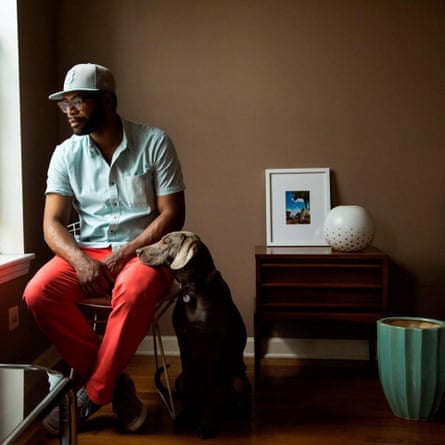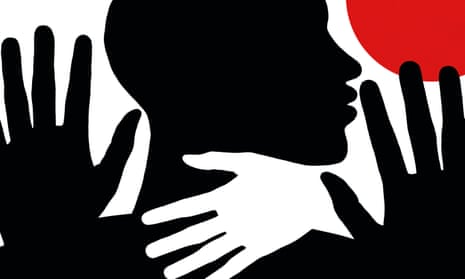In the fall of 2013, very shortly after moving to Detroit, I covered the aftermath of the fatal shooting of Renisha McBride. It was a disturbingly grim story. McBride, a 19-year-old black woman from Detroit, had crashed her car in the middle of the night in the white suburb of Dearborn Heights. Seeking help, she ventured to nearby homes and banged on the door of a white middle-aged man, Theodore Wafer. He responded by shooting her dead through his unopened screen door.
The day I got my brief from editors in New York, I was due to meet with my family friend Justin, a Detroit native who, at the time, was working in the lines at Ford. Feeling a responsibility for me, and knowing me to be so far from home, Justin had quickly taken on a brotherly role with me. I liked to refer to him as my fairy godmother.
We made for an eclectic pair. Justin is 6ft 5in, weighs 300lb and looks like he could be a former American football player. He is black. I am a medium-sized white woman, with peroxide hair and a very British accent. He offered to drive me around as I spoke to neighbors of the shooter, community members, the police and activists.
But as we entered Dearborn Heights, a white suburb, I noticed Justin would let me out of the car but never come with me. When we got to the police station, he shrunk in his car. We had lunch together, and the white waitress scowled when we declared we would share the soup.
“What you don’t see, Rose,” he said to me, “is that I am in danger here.”
It turns out, despite working down the road, Dearborn Heights was a place Justin made sure to never come through. Driving through carried the threat of being pulled over, at the very least. Citing a history of housing discrimination, Justin said he knew he wasn’t welcome there. Detroit activists later referred to Dearborn Heights as a “sundown town” – a place black people would historically know they shouldn’t get caught after dark. Little had changed, they said.
At the police station, white officers welcomed me with open arms. They laughed and made jokes when I told then I lived in the heart of Detroit, a city as overwhelmingly black as their suburb was overwhelmingly white. Was I safe there? they asked me.
There I was, a single young white woman, and everyone near and far was concerned for my safety. But it was the 300lb man next to me, Justin, who was constantly shrinking, silently modifying his behavior to remain safe. To protect his life. He was the body that was unsafe. Constructs and prejudice meant that black and male was a dangerous combination for him.
The killings last week of two black men, Alton Sterling and Philando Castile, at the hands of police, reminded me of the lessons from that day.
In America, black men have historically been depicted as aggressive, hypersexual and violent – to be controlled, to be exploited, to be tamed. The result of that construct and the accompanying racist fear and forced subjugation it justifies has been counterintuitive: black men in America are in fact deeply fragile and constantly at risk.
“The emotional connection I have [to the news] is that it could be me at any time, any day it could be me,” says William Jones, a 22-year-old New Yorker who works in high-end retail.
Every single black man I spoke to for the purpose of this article echoed Jones’s feelings.
“Every day, I live and operate with that feeling of fragility, that feeling that I could be taken out at any time. I am a chokehold away from being Eric Garner,” says Ben Saunders, a 37-year-old professor of psychology at Long Island University.
Up until now, Saunders says that he has been vigilant with himself in public. He makes sure to avoid causing a fuss, even if a fuss is warranted. He suppresses any strong feelings of anger. He doesn’t speak up. His white wife sometimes wonders why not. “Black people have been killed for saying less than that,” he says he responds to her.
The consequence of having to modify his behavior in such a way? “A loss of dignity,” he says.

Joshua Lott, a 37-year-old industry-renowned photojournalist who has traveled across the United States on assignment for the world’s biggest news organizations, says that experience has taught him to always be on edge when he arrives in a new place to work.
“I am extremely cautious, especially when I go into a place where there aren’t many minorities. I know I am a potential target. I am a target because I am a journalist, because I am a black man, I am tall and I wear colors.”
People have called the police on him while he has been on assignment, he says. He recalls sirens and police cars racing towards him in a quiet neighborhood in Arizona where he was covering the housing crisis. A woman had told him he didn’t belong there and called 911.
On top of his usual press credentials, Lott always carries a copy of the New York Times with him, featuring one of his credited photos on the front page. It is a frustrating reality that he knows is a necessary one to keep him safe.
“I shouldn’t have to keep newspapers to tell people what I am doing and what I am about.”
Lott says he has had his fair share of unprovoked “police encounters”, including one very bad case of police brutality that occurred while he was covering a demonstration in Chicago and that was settled out of court, but he considers himself lucky.
“I am extremely fortunate, the cops could have pulled a gun on me and killed me. They could have made up any old thing.”
Michael Oppenheimer, a 39-year-old public defender who has practiced in New York City, Washington DC and Baltimore, says that it is the norm in his job to meet a black or brown man who has just been arrested on a misdemeanor and has suffered a broken nose, stitches or a black eye at the hands of police.
There is little that can be done to seek justice for these men, he says. “The three charges, especially in New York, that ring a bell are disorderly conduct, resisting arrest, and assaulting of a police officer – that’s code for the cops beat you up and now they have to figure out a way to justify it.”
Oppenheimer says that part of what drew him to a career as a public defender is the knowledge that as a black man, however well educated or well dressed you can be, however well you behave, you can be mistreated. There is no escaping it.
“This is not black people saying we feel we are being discriminated against. It is statistical,” he says, referring to data showing a disproportionate number of people killed or subjected to force by police are black.
Oppenheimer has had a policeman draw a gun on him while he was paying for a yellow cab in New York with his credit card after a night out at a restaurant. The policeman, after talking with the cab driver and realizing his mistake – that the lawyer was not in fact robbing the cabbie – told him “you know how it is around here” by way of explanation.
“His response was basically, you know what, black man, you should be used to this. My role in that instance is to shut up and take it. But I was freaked out. You don’t know what’s in other people’s hearts. He could have fired a shot.”
Everyone has a story. It becomes almost like this perverse rite of passage for black men in America.”
Saunders, the psychology professor, says that in any given situation, he makes sure to always be aware of whether there is a police officer around. If one is around, he makes sure to modify his own behavior and be in tune with how he might be perceived at any given moment.
William Jones, the 22-year-old, is 6ft 6in. He says he knows he can be perceived as threatening. He says that is simply not fair. No one is born racist, he points out: racism is taught, and it should be untaught.
Jones knows his historical facts and informs me, sitting on a sidewalk in south Harlem, that not that many years ago I would not have been allowed to interview him. “It’s not just that we wouldn’t have been able to talk, it’s that I could be killed for you talking to me,” Jones says, explaining that history is not that far away. In 1955, 14-year-old African American Emmett Till was lynched in Mississippi after he interacted with a white woman in a grocery store.
“It’s like we are seen as animals. Treated like animals. It’s not easy.”
Jones’s words recall the way in which the Ferguson, Missouri, police officer Darren Wilson who shot black teenager Michael Brown to death, described perceiving Brown as “aggressive”, “angry” and like a “demon” just moments before he ended the 18-year-old’s life.
A psychology study from 2014 authored by Phillip Goff at the University of California found that black children were consistently perceived by police officers as older and less innocent than their white peers.
“We found evidence that overestimating age and culpability based on racial differences was linked to dehumanizing stereotypes,” Goff said of the study.
“Stereotypes always undermine the experience of an individual, or of being in a group,” Saunders, the psychology professor, says. This past week, as he has sought community and to make sense of the events in the news, he says he has witnessed many of his black male friends break down in tears.
“The reluctance to view black men as being fragile is something that has been projected on African American men through stereotyping and prejudice.”
“People think about black men, they do not think of vulnerability. There is not even an opportunity for black men to show vulnerability,” he continues.
But for Saunders, this moment marks a turning point.
The outrage and despair he feels have made him rethink his way of interacting with the world.
“Philando Castile was killed for cooperating. I realized you can be killed for cooperating. That was liberating because I don’t need to focus on cooperating as much,” he says, referring to the fact that Castile was shot by a police officer as he reached for his identification.
Referring to a poem by Paul Laurence Dunbar, Wearing The Mask, he says he is done with the wearing of a mask.
“Through having this unconscious cooperative mindset, I have built good credit with all these people, white people. They have thought of me as the good negro. I am ready to cash every chip that I have in this fight for social justice. Whether or not it means pushing people away. I am willing to cash it all in for this,” he says.
“I always try and approach social justice issues from a place of cooperation, now I am approaching social justice issues from a place of demands.”

Comments (…)
Sign in or create your Guardian account to join the discussion